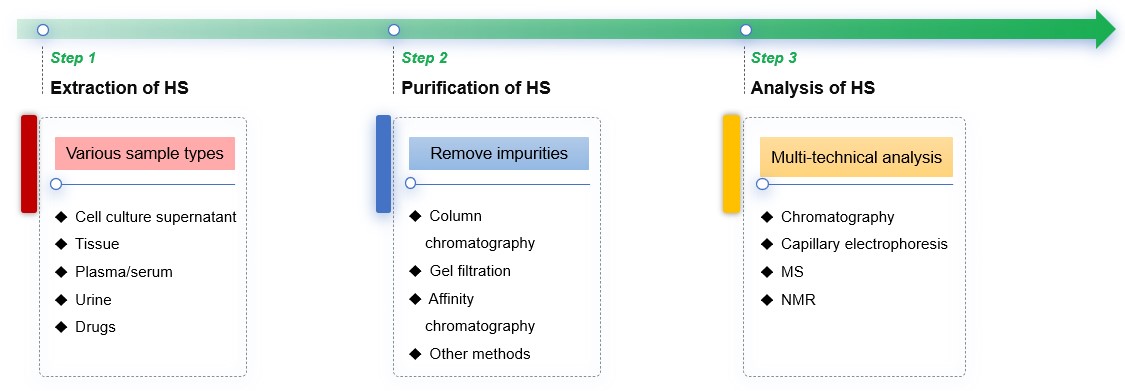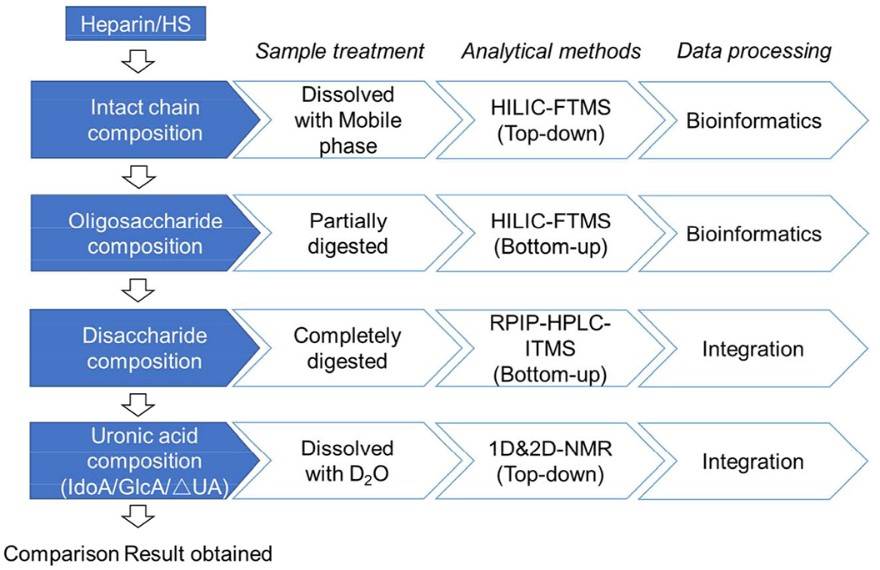Heparan Sulfate Analysis Service
Comprehensive Heparan Sulfate (HS) Analysis at Creative Biolabs
HS is a linear sulfated polysaccharide molecule distributed on the extracellular matrix and cell surface. It usually interacts with cell surfaces, extracellular matrix, and other biological molecules, and participates in regulating biological processes such as cell signaling, cell adhesion, and cell proliferation. However, the heterogeneity and complex structure of HS limit its biological research, so there is an urgent need to develop reliable HS analysis methods. Creative Biolabs has built a mature Carbohydrate Analysis platform. We provide diversified Monosaccharide, Oligosaccharides, and Polysaccharide analysis services, including HS analysis services. Our analysis process is as follows:
-
Extraction of HS
We provide HS analysis for different samples and select appropriate extraction methods according to sample characteristics to ensure that the extraction process has no impact on the integrity and stability of HS.
-
Cell culture supernatant sample
We rinse the cells with the appropriate cell culture medium and collect the supernatant. Enzymes are then used to degrade the protein, and then HS is separated and extracted through centrifugation and other methods.
-
Tissue sample
We perform processing steps such as homogenization and protein removal on tissue samples and then extract HS using methods such as salting out or column chromatography.
-
Plasma/serum samples
We extract HS from plasma/serum using methods such as salting out and ammonium sulfate precipitation.
-
Urine sample
We extract HS in urine through ammonium sulfate precipitation, column chromatography, and other methods.
-
Drug samples
We select appropriate extraction methods according to drug characteristics, such as ion exchange chromatography, column chromatography, and other technologies.
-
Purification of HS
We purify the extracted HS through column chromatography, gel filtration, affinity chromatography, and other methods to remove impurities and other polysaccharides.
-
Analysis of HS
-
Chromatography: We select appropriate chromatographic columns and solvent systems according to different separation principles to separate, detect, and quantify different components in HS and provide diverse structural information. For example, hydrophilic interaction chromatography (HILIC), reversed-phase high-performance liquid chromatography (RP-HPLC), reversed-phase ion pair (RPIP)-HPLC, size exclusion chromatography (SEC), etc.
-
Capillary electrophoresis: We combine reverse polarity capillary zone electrophoresis with mass spectrometry in negative ion mode (CZE-MS) to develop an efficient and sensitive means of analyzing HS, which can detect HS mixtures of different chain lengths.
-
MS: It is used to determine the relative abundance and mass of various ions in HS and help identify its component molecules and structure. It is often used in conjunction with chromatography or electrophoresis to provide more comprehensive information on the structure of HS and greatly improve detection sensitivity. In addition, we combine MS with stable isotope labeling to analyze the role of HS in metabolic pathways through LC-MS/MS.
-
Nuclear magnetic resonance (NMR): It is widely used in the analysis and detection of HS, which provides detailed information on the complete polymer molecular structure, component units, and spatial structure without resorting to chemical or enzymatic cleavage.
There are limitations when using single analytical methods such as NMR and HPLC-MS to analyze HS, and we combine multiple technologies to provide a more complete analysis method for HS. Additionally, we also provide 3-O-Sulfation Analysis and Fiber Analysis services.
 Fig.1 Reliable HS extraction, purification, and analysis services.
Fig.1 Reliable HS extraction, purification, and analysis services.
Published data
HS is an important sulfated polysaccharide that is widely present in the extracellular matrix and cell surface and has multiple physiological functions. The structure of HS contains disaccharide repeating units composed of glucuronic acid or iduronic acid and glucosamine residues. In this study, the authors used a 13C-labeled N-sulfoheparin polysaccharide and eight 13C-labeled disaccharide calibrants as internal standards, then quantitatively analyzed the various disaccharide components and the overall content of HS in biological samples in the same experiment using LC-MS/MS technology. This method had the characteristics of high sensitivity and high throughput, and could effectively detect HS in mouse tissues and plasma. The research showed that this analytical technology plays a vital role in researching the relationship between the structure and functions of HS polysaccharides.
 Fig.2 Validation of disaccharide and recovery calibrants in the HS analysis process.1
Fig.2 Validation of disaccharide and recovery calibrants in the HS analysis process.1
Advantages
-
We provide professional HS analysis for different sample types (such as plasma, urine, tissue, etc.).
-
We focus on carbohydrate analysis and provide high-quality HS analysis services. Moreover, we provide clients with professional data interpretation.
-
We continue to follow the latest analytical technologies and methods, improve the HS analysis process, and provide clients with high-efficiency and high-quality HS analysis services.
Application
-
Drug development: HS is involved in biological processes such as cell signaling and cell adhesion. Its analysis helps assess the impact of potential drugs on biological processes and guides the drug development process.
-
Biomarker development: The structure and expression levels of HS may be relevant to the diagnosis and prognosis of certain diseases. Analyzing HS may provide clues to the search for new biomarkers.
-
Tissue engineering: Analysis of the structure and functions of HS can help guide the development and application of biomaterials and scaffolds.
Creative Biolabs specializes in providing custom synthesis and analysis for carbohydrates and related compounds. We have strong capabilities in the field of carbohydrate analysis and will meet our clients' needs for complex biomolecule analysis. We provide clients with personalized HS analysis services. Please contact us if you would like to acquire our analysis services.
FAQ
Q1: How to prepare samples to ensure efficient extraction and analysis of HS?
A1: Sample preparation typically involves protease digestion, sulfation, or other chemical treatments, resulting in a pure HS sample.
Q2: What technical methods can be used for HS analysis? How sensitive and accurate is the method?
A2: We use common techniques including chromatography (such as centrifugal filtration chromatography, ion exchange chromatography), mass spectrometry, immunoassay, etc. to analyze HS. Sensitivity depends on the chosen analytical method, with some advanced methods such as mass spectrometry capable of detecting very low concentrations of HS, ensuring the accuracy and reliability of the analysis.
Customer Review
Providing Important Biomarker Clues
“I am very happy to receive the analysis results in a short time. Creative Biolabs not only completed the experiment quickly but also provided a detailed report, allowing us to make decisions in time. Through HS analysis, we have discovered potential biomarkers, which may have a significant impact on the diagnosis and prognosis of the disease. I am very grateful to Creative Biolabs for its efforts.”
Advanced Equipment And Technology
“I am impressed by the modern equipment and analytical technology used by Creative Biolabs, which gives me confidence in the reliability of the results. Thank you Creative Biolabs for developing a personalized analysis plan according to our specific sample needs. This targeted service makes our research smoother.”
Reference
-
Wang, Zhangjie, et al. "Quantitative analysis of heparan sulfate using isotopically labeled calibrants." Communications Biology 3.1 (2020): 425. Distributed under Open Access license CC BY 4.0, without modification.
For Research Use Only.
Related Services

 Fig.1 Reliable HS extraction, purification, and analysis services.
Fig.1 Reliable HS extraction, purification, and analysis services.
 Fig.2 Validation of disaccharide and recovery calibrants in the HS analysis process.1
Fig.2 Validation of disaccharide and recovery calibrants in the HS analysis process.1



